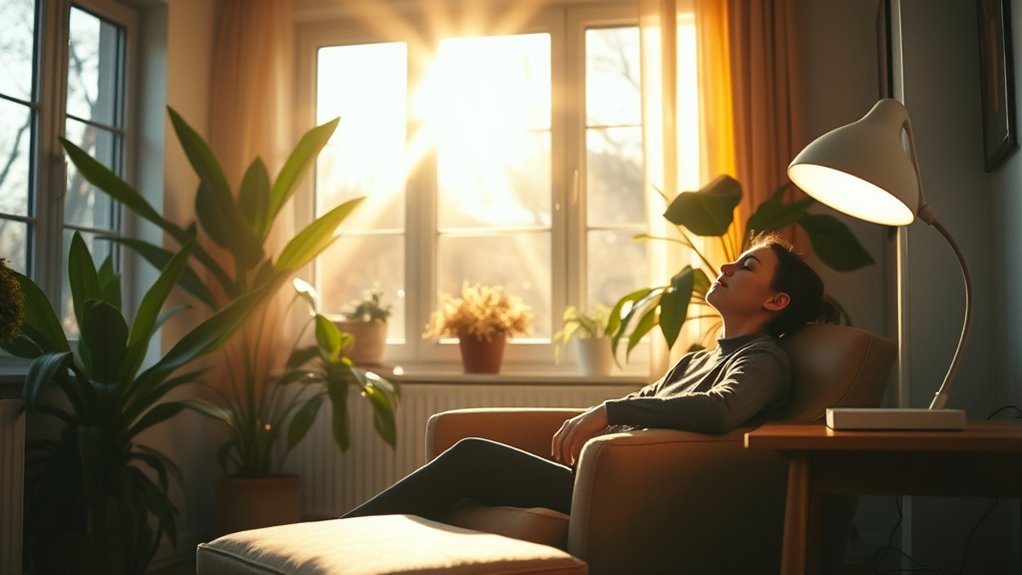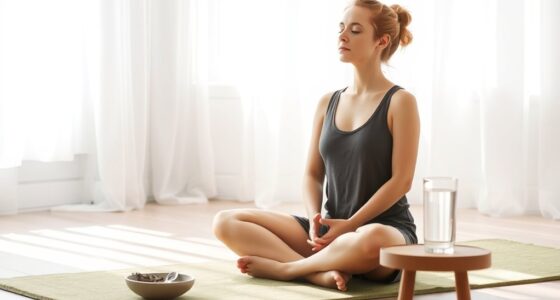If you’re experiencing mood dips, fatigue, or irritability during darker months, bright light therapy could help. This involves sitting about 16 to 24 inches from a specially designed light for 20 to 30 minutes daily, especially in fall and winter. It mimics natural sunlight, resetting your internal clock and boosting serotonin. Using this consistently, along with healthy habits, can improve your mood and energy—you’ll discover more tips to make it work best for you.
Key Takeaways
- Light therapy using a specially designed bright light can effectively treat SAD by mimicking natural sunlight.
- Sitting 16-24 inches from the device for 20-30 minutes daily during fall and winter promotes mood improvement.
- Consistent daily use helps reset circadian rhythms and increases serotonin production, reducing symptoms like fatigue and hopelessness.
- Light devices are safe, comfortable, and more intense than regular indoor lighting, with benefits often seen within weeks.
- Combining light therapy with healthy habits such as exercise, balanced diet, and sufficient sleep enhances overall mood and energy.

Have you ever felt unusually low or sluggish during certain seasons? If so, you’re not alone. Many people experience this pattern of feeling down, tired, or unmotivated when daylight hours shrink, a condition known as Seasonal Affective Disorder. Fortunately, there are effective solutions, and one of the most proven is light therapy. This treatment involves exposure to a specially designed bright light that mimics natural sunlight, helping to regulate your body’s internal clock. When you sit in front of a light therapy box each morning, it floods your eyes with light, signaling your brain to produce more serotonin, a mood-boosting neurotransmitter. As a result, many individuals notice a significant mood improvement, feeling more energetic and balanced as their circadian rhythms reset.
Using light therapy is straightforward. You usually sit about 16 to 24 inches away from the device for 20 to 30 minutes daily during the fall and winter months. The key is consistency—making it part of your daily routine can dramatically influence how you feel. The light emitted by these devices is much brighter than ordinary indoor lighting but is designed to be safe and comfortable for regular use. People often find that incorporating light therapy into their mornings helps them wake up more easily and start their day with a positive outlook. Over time, many report a reduction in symptoms like fatigue, irritability, and feelings of hopelessness, leading to noticeable mood improvement.
Engaging in healthy habits such as regular exercise, balanced diet, and adequate sleep can further enhance the effectiveness of light therapy and support overall well-being. Keep in mind that results can vary from person to person and might take a few days to a couple of weeks to become fully noticeable. Consistency is essential for success, and some may find that adjusting the timing or duration of exposure enhances benefits.
Frequently Asked Questions
Can Bright Light Therapy Be Used Alongside Medication?
You might wonder if combining treatments affects therapy effectiveness. Bright light therapy can safely be used alongside medication, often enhancing overall results. When you combine treatments, it can provide more extensive relief from symptoms. Always consult your healthcare provider before starting or adjusting any treatments, as they can guide you on the best approach. Combining therapies often leads to better outcomes, ensuring you get the most benefit from your treatment plan.
What Are the Best Times of Day for Light Therapy?
You should aim for bright light therapy in the morning to help regulate your circadian rhythm and boost mood throughout the day. If you prefer, evening exposure can also be effective, especially if mornings are challenging. Incorporate light therapy into your morning routines to start your day energized, or schedule sessions in the evening if mornings aren’t ideal. Consistency is key for maximum results.
Are There Any Risks or Side Effects of Light Therapy?
Think of light therapy as a gentle sunbeam—generally safe but with potential pitfalls. You should be aware of safety considerations like eye sensitivity and skin reactions. Side effects, such as headaches or eye strain, are usually mild and manageable. To stay safe, start with shorter sessions and consult a healthcare professional. Monitoring your response helps manage side effects, ensuring you get the benefits without unnecessary risks.
How Long Does It Typically Take to See Improvement?
You might wonder how long it takes to see symptom improvement with light therapy. Typically, the treatment timeline shows noticeable results within one to two weeks, though some people notice changes sooner. Consistent daily use of the light box is key, as it helps regulate your mood and energy levels. Keep in mind, individual responses vary, but patience and adherence usually lead to meaningful symptom improvement.
Can Light Therapy Be Effective for Other Mood Disorders?
Have you wondered if light therapy can help with other mood disorders? It’s quite possible because light therapy influences your circadian rhythm, which affects your sleep and mood. While it’s most effective for seasonal variations, some studies suggest it may also assist with non-seasonal depression and bipolar disorder. You should consult a healthcare professional to see if light therapy fits your specific situation and can complement your treatment plan.
Conclusion
Just like a lighthouse guides ships safely to shore in stormy weather, bright light therapy can steer you through the dark days of seasonal affective disorder. I once heard from someone who started daily light therapy and felt their mood brighten like sunrise after a long, starless night. Remember, these solutions aren’t just about light—they’re about shining hope into your life. With consistent effort, you can weather the winter blues and find your way back to brightness.









